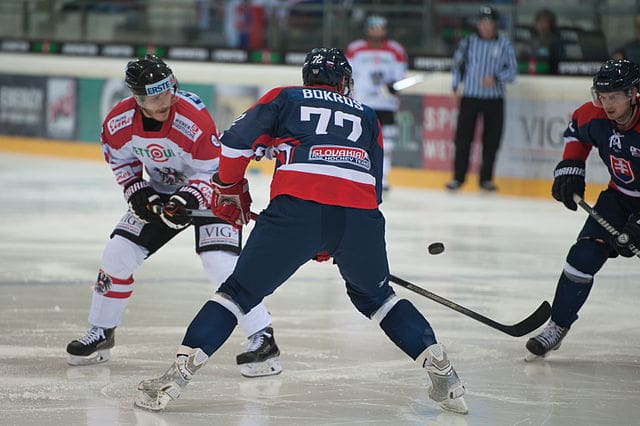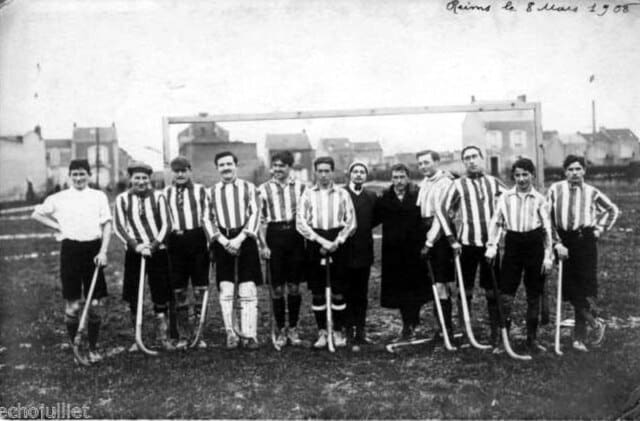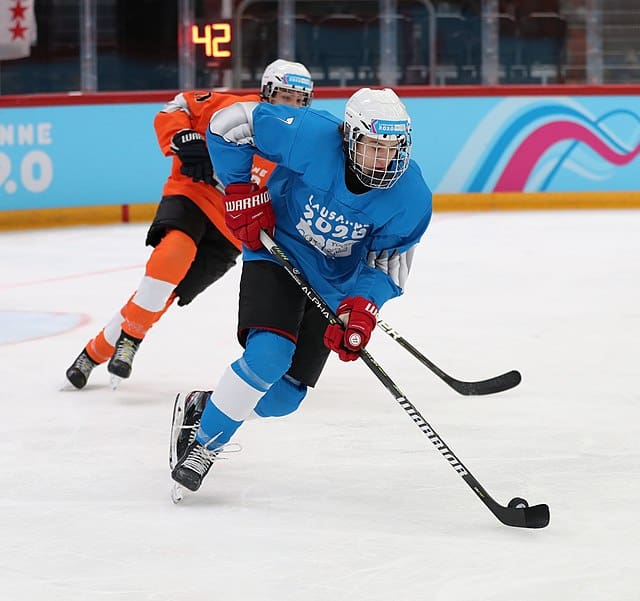Who Invented Hockey? 10 Great Facts and Stories
Hockey, a compelling and fast-paced sport, has caught the hearts of millions of people all over the world. The game’s beginnings are veiled in history and development, and it has progressed from ancient civilizations’ stick-and-ball hobbies to current ice arenas.
Hockey’s unique combination of skill, strategy, and friendship has made it a global craze, whether played on frozen ponds, indoor rinks, or international stages.
The sport’s long tradition of invention and competitiveness continues to unite spectators and participants in a spectacular display of athleticism and collaboration as players glide around the ice, using sticks to push pucks and score goals.
Inventor Of Hockey

20150207 1850 Ice Hockey AUT SVK 9930.jpg Ailura, CC BY-SA 3.0 AT, CC BY-SA 3.0 AT, via Wikimedia Commons
The actual origin and creator of hockey are still a source of contention and controversy. While many versions of stick-and-ball games have been played by civilizations throughout history, no one person or group can be definitely attributed with “inventing” hockey.
Hockey’s growth was a long process that featured contributions from various cultures and places over time. Early versions of the game were played all across the world, including Europe and North America.
It is vital to highlight that the creation of hockey was the product of a collaborative effort spanning centuries and influenced by different cultures and games.
Facts And Stories About Hockey
Here are important facts and stories about Hockey from the time of invention to date;
1. It is believed that hockey’s roots can be traced back to ancient civilizations

France hockey team 1908.jpg Here, Public domain, via Wikimedia Commons
The roots of hockey are unknown, with suggestions pointing to ancient civilizations. Ancient Egyptians, Greeks, and Native Americans all played stick-and-ball games, which may have influenced the creation of early hockey-like activities.
While exact linkages are uncertain, these ancient forerunners highlight the universal attraction of manipulating things with instruments, maybe contributing to the evolutionary trajectory of what would become contemporary hockey.
2. One popular theory suggests that the indigenous Mi’kmaq people of Nova Scotia played a role in the development of early hockey
According to popular belief, the indigenous Mi’kmaq people in Nova Scotia, Canada, shaped the early phases of hockey’s formation. The Mi’kmaq used sticks to manage a ball in a game known as “Amerindian Lacrosse,” which resembled early forms of hockey.
This indigenous impact emphasizes the complicated interplay between cultures and traditions, implying that the Mi’kmaq’s stick-based sport may have played a part in the progressive evolution of these activities into what we now call hockey.
3. Early European variations shaping hockey’s ancestry

Hockey match (AM 85990-1).jpg Auckland Museum, CC BY 4.0, via Wikimedia Commons
Throughout Europe, a variety of stick-and-ball games blossomed, adding to the tapestry of hockey’s growth. Among these, “shinty” in Scotland stands out as a notable forerunner, having a striking resemblance to modern hockey.
Simultaneously, “hurling” in Ireland grasped the spirit of the sport, using curved sticks to push a ball, highlighting the deep links between these ancestral sports and the ultimate evolution of contemporary hockey.
4. Early 1800s Nova Scotia saw “Hurley on the Ice” which was a precursor to modern hockey
During the early 1800s, the Windsor community in Nova Scotia enjoyed a unique winter game known as “Hurley on the ice.” Participants in this unusual game used curved sticks to guide a wooden ball over frozen ponds.
Surprisingly, this historical reconstruction is recognized as one of the first known occurrences resembling contemporary hockey, highlighting its vital significance in the sport’s early phases and providing insight into the roots of this cherished frosty activity.
However, it wasn’t until the Halifax Rules were established in 1850 that this formative activity started to crystallize into a more organised and regulated sport. These regulations, while simple by modern standards, provided the framework for a more consistent gaming experience.
They pioneered techniques that would ultimately become standard in contemporary hockey, such as determining the number of players on each team and defining offensive and defensive duties.
5. The Stanley Cup, one of the most iconic trophies in Hockey, was donated by Lord Stanley of Preston in 1892
Lord Stanley of Preston presented the renowned Stanley Cup on sports history in 1892. This cherished trophy, a symbol of sports brilliance, has long represented the summit of success in the world of competition.
Lord Stanley’s gesture not only sealed his position in hockey history but also created an enduring legacy, motivating generations of sportsmen to strive for excellence and have their names etched in the annals of historic heritage. The Stanley Cup is a monument to sports’ ability to unify, inspire, and elevate the human spirit.
6. The modern rules of hockey started to take shape in the late 19th century

2020 Winter Youth Olympics .jpg Sandro Halank, Wikimedia Commons, CC BY-SA 4.0, CC BY-SA 4.0, via Wikimedia Commons
The characteristics of contemporary hockey regulations began to form in the late nineteenth century. The pioneers of the sport strived to construct a unified framework, guided by a growing spirit of order and justice.
As sticks met ice and players manipulated the puck, innovations such as team boundaries, the introduction of the puck as a standard, and offside and icing laws revolutionized the game. This watershed moment signalled the transition from an informal hobby to a more standardized and strategic sport, influencing the dynamic and fascinating gameplay we enjoy today.
Read On Top 10 Facts about Canada Olympic Park, Calgary
7. Hockey became an official Olympic sport in 1920
In a watershed moment, hockey was granted Olympic status in 1920. The Olympics embraced the sport, providing it with a larger platform for worldwide competition. The rinks became arenas of athleticism and friendship, with players dressed in the colours of their respective countries.
This admission was a watershed moment, cementing hockey’s place among the world’s most famous sports and demonstrating the sport’s ability to build togetherness through competition. The Olympic rings accepted hockey, including its past into the fabric of the world sporting legacy, where nations compete with zeal and sportsmanship for success and glory.
8. The National Hockey League (NHL) was founded in 1917

Field hockey at the 2012 Summer Olympics – NZL-AUS (7796665032).jpg Ross Huggett, CC BY 2.0, via Wikimedia Commons
The National Hockey League (NHL) was founded in 1917 as a major cornerstone of the sport. The NHL, founded with the goal of professionalizing and standardizing hockey in North America, created the groundwork for a new age of competitiveness.
With teams from both the United States and Canada, the league increased the game’s ability, strategy, and excitement. The formation of the NHL was a watershed moment in the history of the sport, influencing its expansion, popularization, and the creation of famous players whose names would live on in the annals of hockey history.
Read On 70 Iconic Sports Quotes That Inspire Beyond the Field
9. The first recorded women’s hockey game took place in 1892
With the first documented women’s hockey game in 1892, a historic milestone was attained. This historic occasion marked the beginning of women’s participation in a sport that would inspire future generations. Women’s hockey grew from that pioneering moment, gathering pace and establishing its own way in the world of sports.
The game was a monument to female athletes’ enthusiasm and drive, and their efforts have since transformed the landscape of hockey, stressing the significance of gender equality and inclusiveness in sports and leaving an everlasting stamp on the game’s history.
10. In the Winter Olympics, there are typically 12 men’s ice hockey teams and 10 women’s ice hockey teams that compete

2020 Winter Youth Olympics.jpgSandro Halank, Wikimedia Commons, CC BY-SA 4.0, CC BY-SA 4.0, via Wikimedia Commons
A usual format for the Winter Olympics comprises the participation of 12 men’s ice hockey teams and 10 women’s ice hockey teams. These teams represent nations from all around the world, who have gathered to demonstrate their abilities and compete for Olympic glory.
While this structure may vary slightly based on various Olympic editions and organizational decisions, it assures a lively and varied group of athletes competing in high-stakes competitions on the frozen rink. The men’s and women’s tournaments give an international platform for the best hockey players to compete for coveted medals and demonstrate the unifying force of sport on a global scale.
Hockey’s attractiveness stems from the combination of talent, friendship, and worldwide enthusiasm. It represents a dynamic journey that crosses boundaries, from ancient roots to current venues. With each puck glide, it creates a symphony of competition and unity, drawing spectators from all around the world under its spell. Hockey is more than simply a game; it is an incredible experience that grabs hearts and forges long-lasting bonds.
Read On The 30 Greatest Hockey Players of All Time
Planning a trip to Paris ? Get ready !
These are Amazon’s best-selling travel products that you may need for coming to Paris.
Bookstore
- The best travel book : Rick Steves – Paris 2023 – Learn more here
- Fodor’s Paris 2024 – Learn more here
Travel Gear
- Venture Pal Lightweight Backpack – Learn more here
- Samsonite Winfield 2 28″ Luggage – Learn more here
- Swig Savvy’s Stainless Steel Insulated Water Bottle – Learn more here
Check Amazon’s best-seller list for the most popular travel accessories. We sometimes read this list just to find out what new travel products people are buying.









